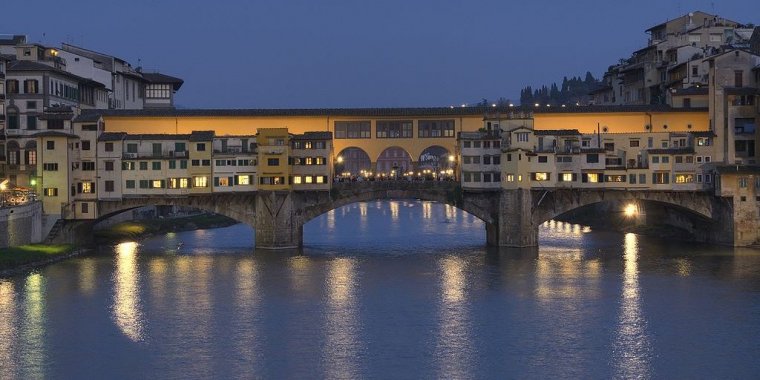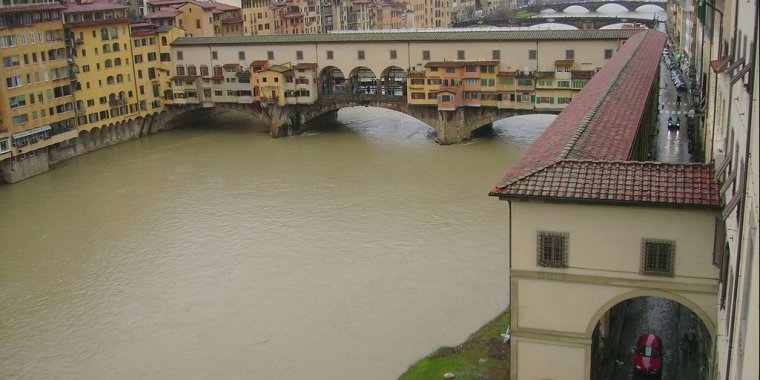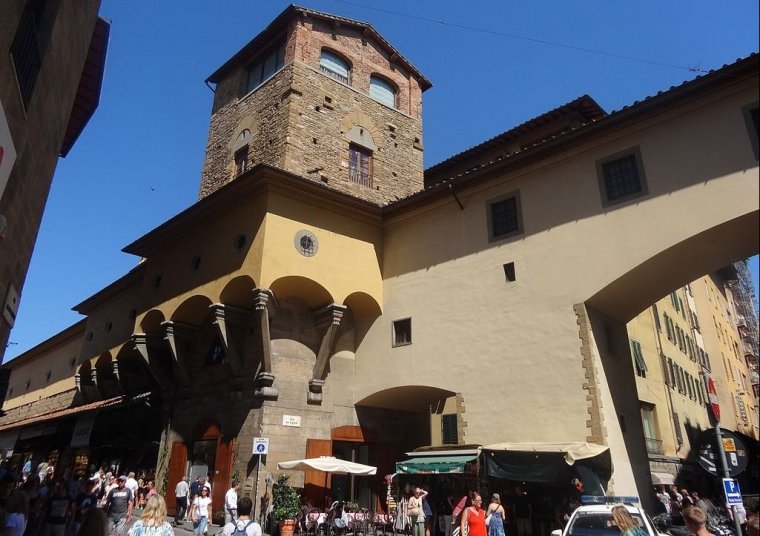| Published in Attractions / Places of Interest |
Ponte Vecchio, Florence, Italy

Ponte Vecchio over the river Arno in Florence Italy. ![]()
The Ponte Vecchio ("Old Bridge") is a medieval stone closed-spandrel segmental arch bridge over the Arno River, in Florence, Italy. It is noted for its shops built along it, as was once common. Butchers initially occupied the shops; the present tenants are jewelers, art dealers, and souvenir sellers. The Ponte Vecchio's two neighboring bridges are the Ponte Santa Trinita and the Ponte alle Grazie.
The bridge spans the Arno at its narrowest point where it is believed that a bridge was first built in Roman times, when the via Cassia crossed the river at this point. The Roman piers were of stone, the superstructure of wood.
The bridge first appears in a document of 996. After being destroyed by a flood in 1117, it was reconstructed in stone but swept away again in 1333 except for two of its central piers, as noted by Giovanni Villani in his Nuova Cronica.
It was rebuilt in 1345. Giorgio Vasari recorded the traditional view of his day that attributed its design to Taddeo Gaddi — besides Giotto one of the few artistic names of the trecento still recalled two hundred years later.
Modern historians present Neri di Fioravanti as a possible candidate as builder. Sheltered in a little loggia at the central opening of the bridge is a weathered dedication stone, which once read Nel trentatrè dopo il mille-trecento, il ponte cadde, per diluvio dell' acque: poi dieci anni, come al Comun piacque, rifatto fu con questo adornamento.
The Torre dei Mannelli was built at the southeast corner of the bridge to defend it.
The bridge consists of three segmental arches: the main arch has a span of 30 meters (98 feet) the two side arches each span 27 meters (89 feet). The rise of the arches is between 3.5 and 4.4 meters (11½ to 14½ feet), and the span-to-rise ratio 5:1.
It has always hosted shops and merchants who displayed their goods on tables before their premises, after authorization by the Bargello (a sort of a lord mayor, a magistrate and a police authority). The back shops (retrobotteghe) that may be seen from upriver, were added in the seventeenth century.
During World War II, the Ponte Vecchio was not destroyed by the German army during their retreat at the advance of the British 8th Army on 4 August 1944, unlike all the other bridges in Florence. This was, according to many locals and tour guides, because of an express order by Hitler. Access to the Ponte Vecchio was, however, obstructed by the destruction of the buildings at both ends of the bridge, which have since been rebuilt using a combination of original and modern designs.

The Ponte Vecchio and the Vasari Corridor over the Arno in Florence, Italy. ![]()
In order to connect the Palazzo Vecchio (Florence's town hall) with the Palazzo Pitti, in 1565 Cosimo I de' Medici had Giorgio Vasari build the Vasari Corridor above it. To enhance the prestige and clean up the bridge, in 1593 the Medici Grand Dukes prohibited butchers from operating and selling there. Their place was immediately taken by several gold and silver merchants.
A decree was made in 1595 that excluded butchers from this bridge (only goldsmiths and jewelers are allowed) that is in effect to this day. The association of butchers had monopolized the shops on the bridge since 1442.
A stone with an inscription from Dante (Paradiso xvi. 140-7) records the spot at the entrance to the bridge where Buondelmonte de' Buondelmonti was murdered by the Amidei clan in 1215, which began the urban fighting of the Guelfs and Ghibellines.
Source
• www.wikipedia.org
YOU MAY ALSO LIKE





 If you own or manage a travel-related business such as a hotel, a bed-and-breakfast, a restaurant, a pub or a cafeteria, you can create a web page for your business for free on Titi Tudorancea Travel Info. » |

